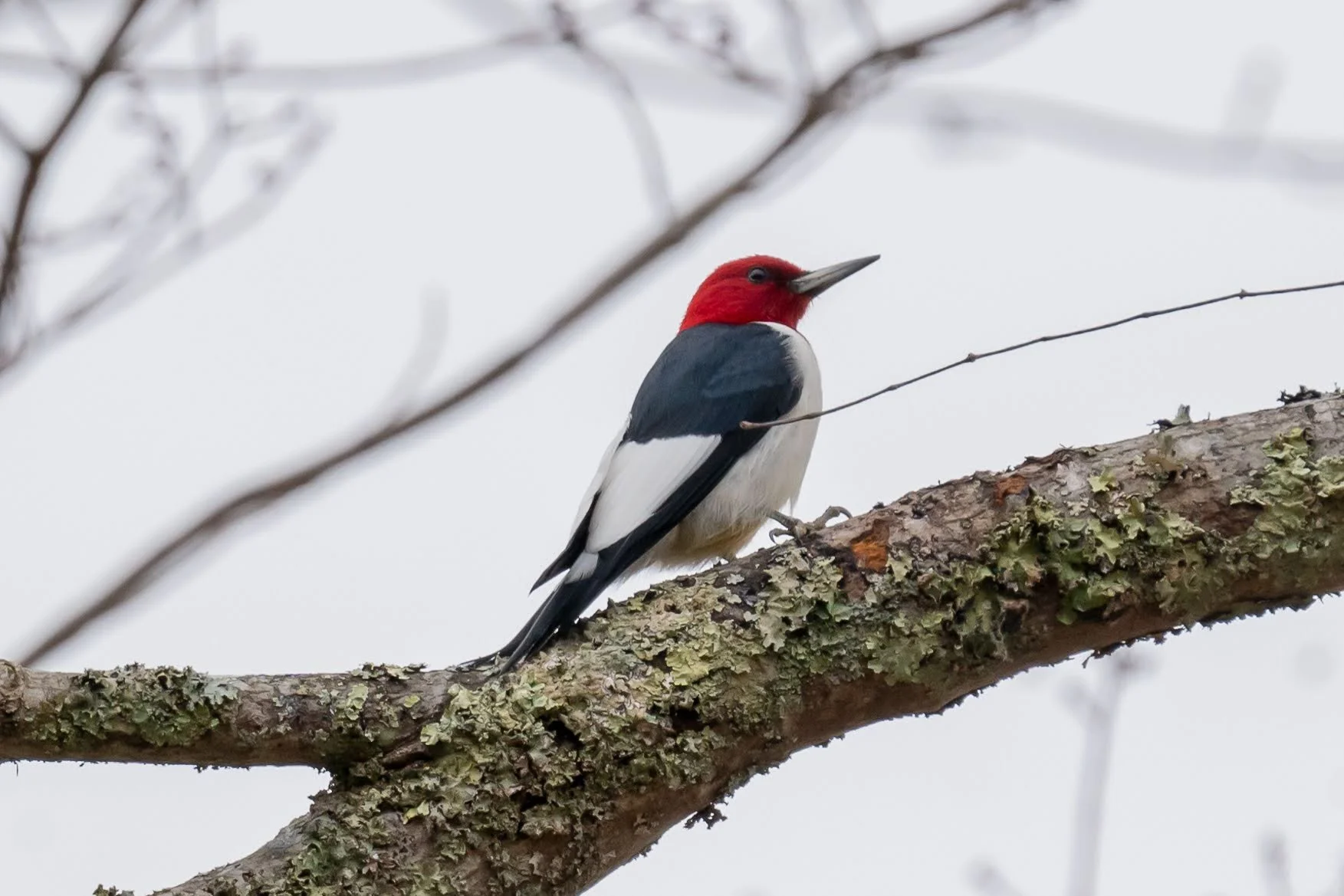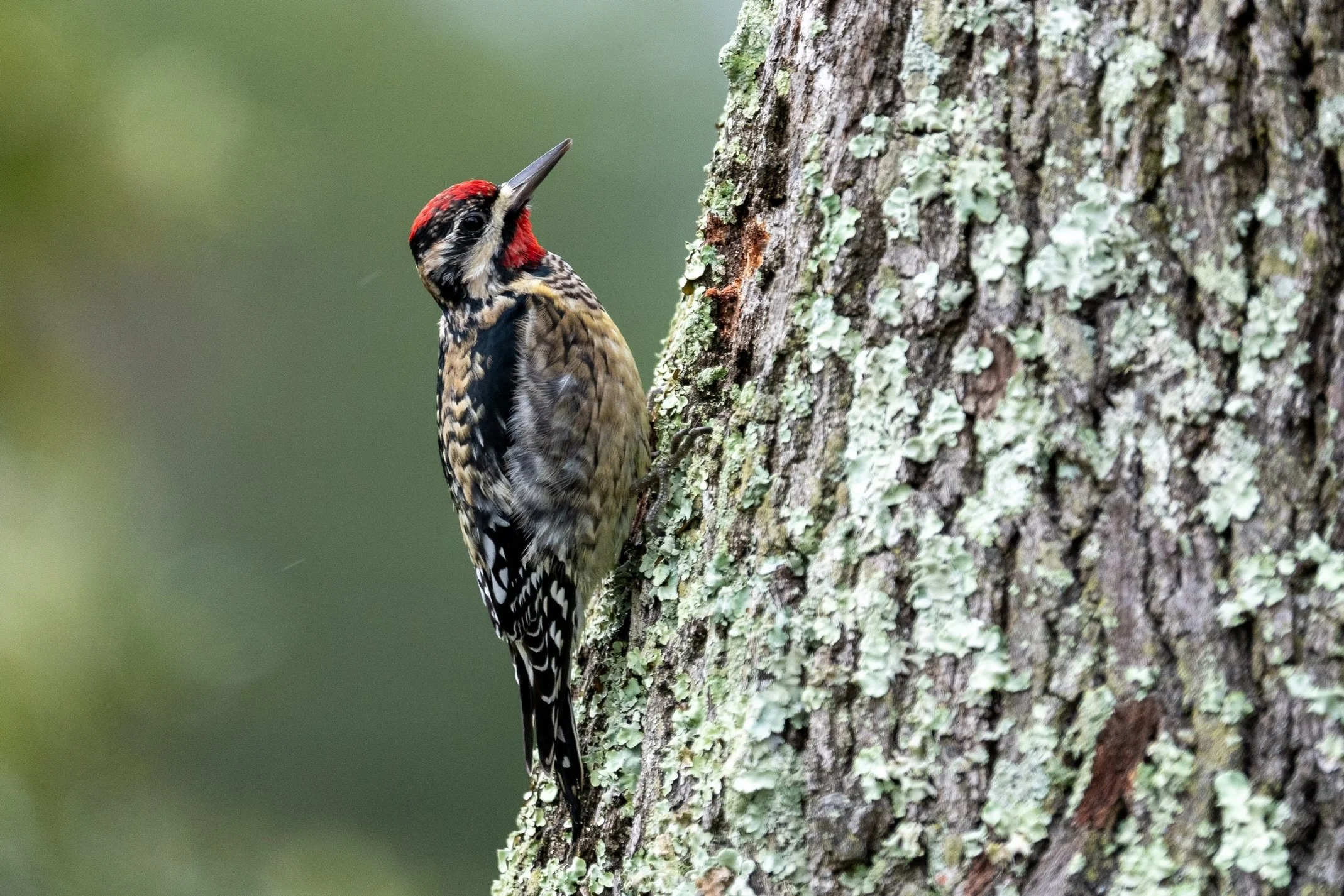Native Woodpeckers of the Blue Ridge Mountains
Who’s that knocking on your door? Who else but your friendly, neighborhood native woodpeckers! Here in the Blue Ridge Mountains, we’re lucky to have six native woodpecker species. And while they may all have their own unique features, they do share some common characteristics.
Woodpeckers’ feet and beaks are designed perfectly for the work that they do.
Special Adaptations
The behavior that most woodpeckers are known for, hammering away at trees, is possible because of a few special adaptations. Unlike other birds, the bones between a woodpecker’s skull and beak are joined by flexible cartilage that helps absorb shock. But that’s not all—their tongues also absorb some of the force.
Woodpecker tongues are attached to the hyoid bone, which starts behind their upper beak, splits in two, and wraps around their skull, connecting back together behind their lower beak. The muscle stabilizes the skull and spine while hammering. Those methods of shock absorption keep them from being constantly concussed!
It isn’t easy staying steady when drilling away, so woodpeckers also need a strong support system holding them against the tree. Most bird species have anisodactyl feet, with three toes in front and one behind. Woodpeckers have zygodactyl feet, with two toes in front and two toes in back. They’re often described as X- or K-shaped. It gives them better grip for when they’re hammering, or hopping their way up the side of a tree. Lastly, woodpeckers have stiffened tail feathers that they can “lean back on” as they hammer to help keep them anchored.
Native Species
Northern Flicker
Northern Flickers (Colaptes auratus) have a peachy face, gray crown, red nape, black bib, and a light belly covered in black spots. When they fly, you can see their white rump! Males have a black “mustache”. For a long time, scientists thought there were two species of flicker: an eastern and western one. The main difference? Eastern flickers have yellow-shafted flight and tail feathers, western flickers have red-shafted feathers. In the middle of their range, the populations often hybridize and take traits from each morph, or combine them into intermediate characteristics. The Flicker also acts a little different than the other woodpeckers—it likes to get its food from under the ground! That doesn’t mean the northern flicker can’t use its beak to drill into trees, it just has a preference.
A Downy Woodpecker enjoying a seed snack at our main campus!
Downy Woodpecker & Hairy Woodpecker
Two of our most common woodpecker species, the Downy (Picoides pubescens) and Hairy (Leuconotopicus villosus), are so similar that they’re often confused! Both have a black and white pattern, and males have a red spot on their head. But there are some tricks to spotting the difference! Both species have white outer tail feathers, but the downy sometimes has black spotting as well. Hairy woodpeckers are slightly larger in size. The key identifier is beak size; a Downy’s beak is shorter than its head, and a Hairy’s is the same length as its head. Pairs of Downy woodpeckers love to use the “divide and conquer” strategy when foraging—males collect from small branches and plant stems, females go to larger branches and tree trunks. They can often collect food that the larger woodpeckers can’t get, like the fly larvae in goldenrod stems! Hairy woodpeckers like to pick up the scraps left behind by other woodpecker species—ants from the Pileated, and even sap left by sapsuckers!
Red-bellied Woodpecker
A Red-bellied Woodpecker—you can barely see the red wash on his underbelly.
Red-bellied woodpeckers (Melanerpes carolinus) have light bodies, black and white barred wings, and red on their head and belly. Males have a red crown and nape, while females only have a red nape. Their red belly is usually hidden by other feathers and is very difficult to see. This woodpecker gets the honor of having the longest tongue out of all the woodpeckers; it can extend two inches past the beak tip! Males have longer tongues with slightly wider barbs at the end, which scientists theorize is so that mated pairs can forage in different areas of their territory. If they have a piece of food that’s too large to crack with their beak, like a nut, they’ll wedge it in some tree bark to hold it steady.
A fiery (and territorial) Red-headed Woodpecker!
Red-headed Woodpecker
Red-headed Woodpeckers (Melanerpes erythrocephalus) are easily recognizable by their scarlet-colored head, white belly, and half-white/half-black wings, Red-headed Woodpeckers are a common sight in the Blue Ridge Mountains this time of year. And they’ve got pretty…. intense personalities. When it comes to territory disputes, these birds don’t mess around. They’ll destroy nests and remove or puncture unattended eggs. To survive the winter, they store food in the bark of trees. Similar to a White-breasted Nuthatch. The big difference? They don’t just store seeds—they also store live insects! Wedged in so tightly between cracks in the bark, insects can only wait for the woodpecker to come back and gobble them up!
Woody the Woodpecker was modeled after this handsome Pileated Woodpecker!
Pileated Woodpecker
Unlike our other native woodpeckers, Pileated woodpeckers (Dryocopus pileatus) are much larger—almost the size of a crow. However, they do follow the very-popular woodpecker color scheme of black, white, and red. Both males and females have a giant, red mohawk of feathers, called a crest, and some white striping on their face and neck—but only the males have a red mustache! You’ll know you have a pair of Pileateds in the area if you start to see large, rectangular holes in your dead trees. They carve them out as they hunt for ants. After a foraging hole is abandoned, other birds and mammals may take it over. Pileated woodpeckers are important habitat providers for many different cavity-nesting species, like owls and squirrels
An adaptable and opportunistic species, Yellow-Bellied Sapsuckers eat tree sap, seeds, and insects!
Yellow-bellied Sapsucker
The Yellow-bellied sap-sucker (Sphyrapicus varius) lives here during its non-breeding season, from October to March, and then leaves for the north. They look somewhat similar to Downys and Hairys, but have a couple distinct features. When their wings are folded, they have a large, vertical white patch. Both males and females have a red crown, but only males have a red throat to match. Despite what half their name suggests, their yellow belly is difficult to see. Like the second part of their name suggests, though, drinking sap is a sweet part of their diet! They have two different techniques for harvesting it. In early spring, when sap is flowing from the roots to the branches on a warm day, they drill small, circular holes in a horizontal line until they reach the xylem. Then they use their long, brush-like tongue to lap up the sap. Once the trees leaf out, they drill larger, shallower “wells” that only need to reach the phloem. Then they can catch the sap being brought down from the leaves- which can be up to 10% sugar. They prefer maples or birches, but have been recorded as sampling sap from as many as 1,000 different tree/woody plant species.
What woodpeckers have you seen this year? Let us know in the comments!





